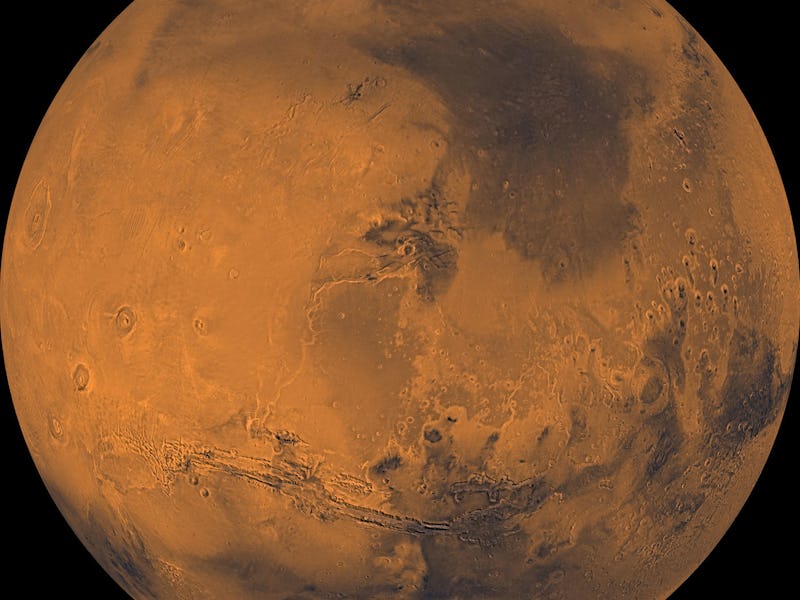Mars is one of our closest planetary neighbors, making it a popular celestial object for scientists and amateur astronomers alike. For centuries, humanity has been interested in the red planet and its potential inhabitants. Thanks to a fleet of robotic explorers, scientists are able to search for clues to determine whether or not Mars could have hosted life. Here’s a look back at some of the top Martian discoveries of 2016.
Mars Is Hiding a Secret Stash of Water
Last month, a research team from the University of Texas announced that Mars is hiding a secret supply of water just below its surface. They reported that Utopia Planitia, a region on Mars, is harboring as much water as Lake Superior here on Earth — only difference is that the Martian reserves are frozen solid. The ice reservoir, reportedly the size of New Mexico, is excellent news for future human missions.
Meteorites on Mars
In November, Curiosity surprised scientists when it stumbled upon an interesting find: a small metallic meteorite subsequently dubbed “Egg Rock”. While meteorites on Mars are common, this one’s smooth surface is not. The data collected will provide details about how meteorites are affected when exposed to the Martian environment for long periods of time, which fits with Curiosity’s newest science goal: to investigate how ancient environmental conditions changed over time.
Curiosity's view of "Egg Rock."
Mars Once Had an Oxygen-Rich Atmosphere
Mars used to have a lot more oxygen than scientists thought. Curiosity’s ChemCam instrument detected high levels of manganese oxide in rocks that lined the Kimberley region of Gale Crater. This evidence supports the idea that free oxygen once flowed across the Martian surface, during a period when the planet was warmer, and its surface was teeming with vast lakes and oceans.
Boron and Interesting Chemistry
The Curiosity rover is currently studying an intriguing mountain on Mars that is geologically-speaking, very interesting. The data shows that this particular mountain is full of groundwater, which means the rocks could be chemically active, making it a prime location for microbial life. Curiosity also detected its first traces of boron on Mars.
Marsquakes Could Have Helped Spawn Life
Earthquakes — which are usually terrifying natural disasters — could have helped foster life on the red planet. A recent study published in the journal Astrobiology revealed that earthquakes produce rocks with an abundance of trapped hydrogen. When applied to extraterrestrial worlds, the research indicates that “marsquakes” could encourage the type of hydrogen-rich geology (known as serpentinization) necessary to support life.
Sniffing Out Signs of Life
The red planet is going to be a busy place in the coming years as multiple space agencies have their sites set on Mars. This year, the European Space Agency teamed up with Roscosmos to launch the first of two planned Mars missions, dubbed ExoMars. The mission was mostly successful as its Trace Gas Orbiter (TGO) successfully achieved Mars orbit, while its lander, Schiaparelli, crashed on the Martian surface.
Unfortunately, Schiaparelli failed to land on Mars, but ESA will try again in 2020.
The next iteration will hopefully have better luck, as it roams the red planet in search of any signs of life — be it extinct or extant. The TGO will analyze the Martian atmosphere, searching for evidence of trace gases, such as methane, which could be indicators of life.
The mission will be roaming around the red planet at the same time as NASA’s next Mars rovers — Mars 2020. The future robot will be a souped up version of the Curiosity rover, designed to search for signs of life. It will also have the ability to box up interesting samples to be retrieved at a later time.
NASA's Mars 2020 rover will be a souped up version of Curiosity.
SpaceX and Human Missions
We know that NASA is planning its journey to Mars, but the space agency may not be the first to the red planet. In September, SpaceX ignited fans all around the world, when the company revealed its plans for sending humans to Mars via its massive Interplanetary Transportation System.
SpaceX also has plans of sending its robotic Dragon capsule to the Martian surface to test out technologies needed on future missions. The cargo capsule will also deliver supplies and could ferry cached samples back to Earth.
The ITS will one day transport humans to the red planet.
